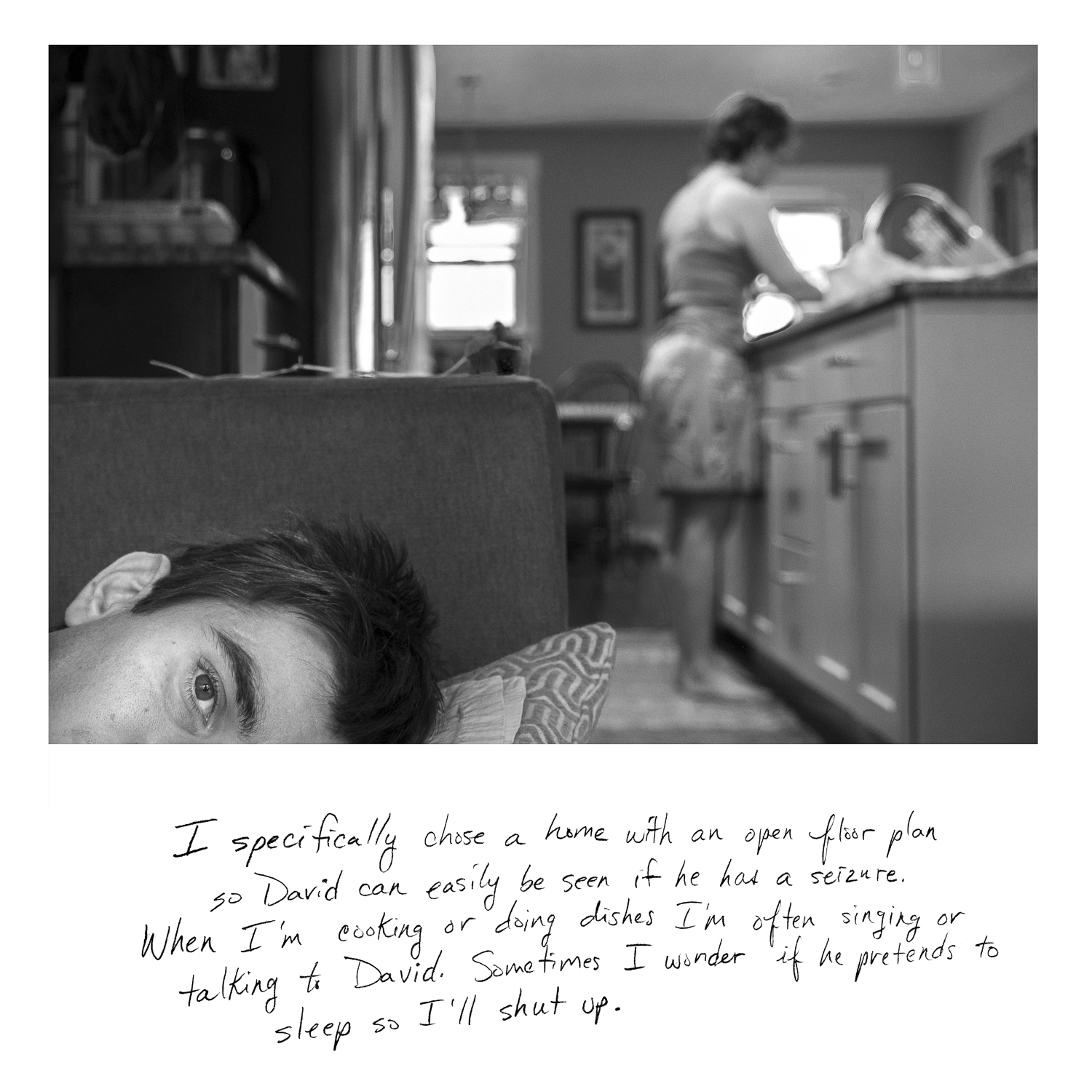
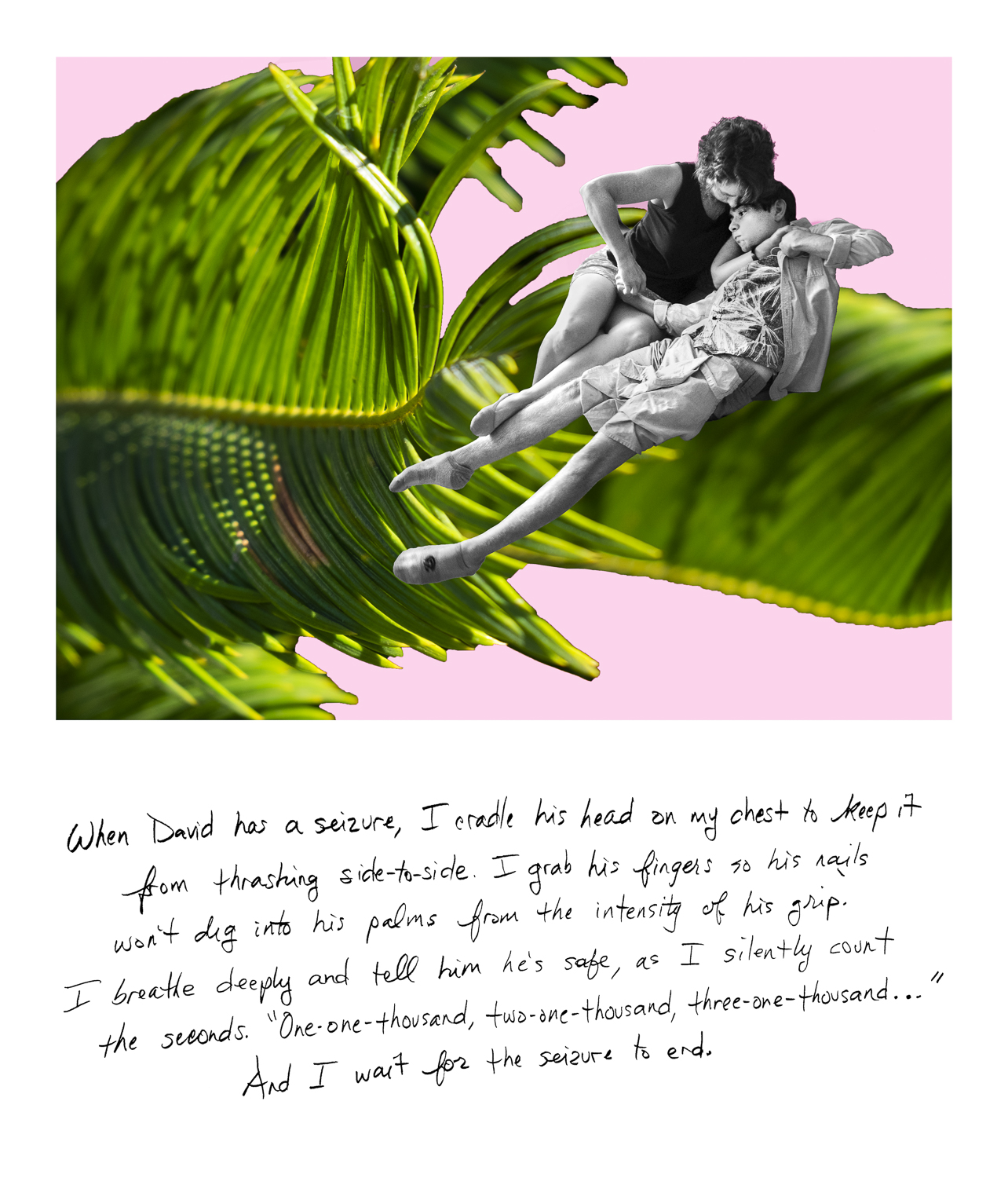
“When David was a baby, I sang a special song to him,” Debe Arlook, David’s aunt, tells me. “I still do, and it seems to warm his heart because it makes him smile.” For more than two years now, Arlook has been collaborating with her sister Lori, David’s mom, to tell the story of their family.
Today, David is 28 years old. He loves music and walking in the foothills of the Rocky Mountains. David is also on the autism spectrum and has Lennox-Gastaut Syndrome, a severe form of epilepsy that causes multiple types of seizures that are resistant to treatment.
Over the years, Lori has developed a meditation practice, based on a range of spiritual studies, to help her navigate the responsibilities of being a full-time caregiver. In addition to conventional medicine, she’s also consulted healers working with energy; some have told her that, in certain cultures, seizures are believed to create an altered state—and that perhaps David does healing work within spiritual realms beyond our understanding.
“I find it remarkable there’s a possibility he is a healer working on other planes,” Arlook says. “We and other families have been told people like him have this ‘gift.’” Lori’s handwritten words accompany Arlook’s photographs in their project, one, one thousand… An “unconventional documentary,” the series draws its title from Lori’s counting during David’s seizures, measuring how long they last. The seizures occur nearly every day. As of now, there is no cure for LGS.
David is non-verbal, but it was vital for Arlook to have his consent, as well as Lori’s, before embarking on the project. “Because his communication is limited, I had no idea if he’d understand what I was asking or if he’d respond,” the photographer says. “I explained I would photograph him with respect and honor. If I ever felt he was uncomfortable, I would stop.”
David learned toward his aunt, met her eye, and stayed there for a long time before leaning back. He had never done that before. “We had our ‘yes,’” Arlook says now. “I felt I was witnessing a miracle.” She lived with them for a month in 2020 and has returned to work with them, as months turned to years.
During that time, Arlook, Lori, and David have been part of exhibitions and talks about LGS and the experiences of caregivers. Until February of next year, the work will be on view at the University of Colorado Anshutz Medical Campus, Fulginiti Pavillion for Bioethics and Humanities. “My sister gave two talks for student doctors there,” Arlook explains.
“They were brought to tears by the photographs and were grateful to have the opportunity to learn more about a real-life scenario.” A portion of photographs sold goes to the Lennox-Gastaut Syndrome Foundation. You can also support the Foundation directly through this fundraiser, hosted by the family. There will be a hybrid talk and artist reception tomorrow, Tuesday, November 1st, International Lennox-Gastaut Syndrome Awareness Day.
Window light shines throughout Arlook’s photographs of David and Lori, reflecting off of David’s Mardi Gras beads (“he jiggles them with a repetitive behavior that’s common in individuals on the autism spectrum,” the artist says), illuminating their skin, and glittering in their eyes. When David was young, his aunt would hold him in her arms and watch as his gaze followed the light as it fell across the room throughout the day. “I wondered what he was seeing,” the photographer tells me. “I still do.”
We asked David’s aunt and mother to tell us more about their collaboration.
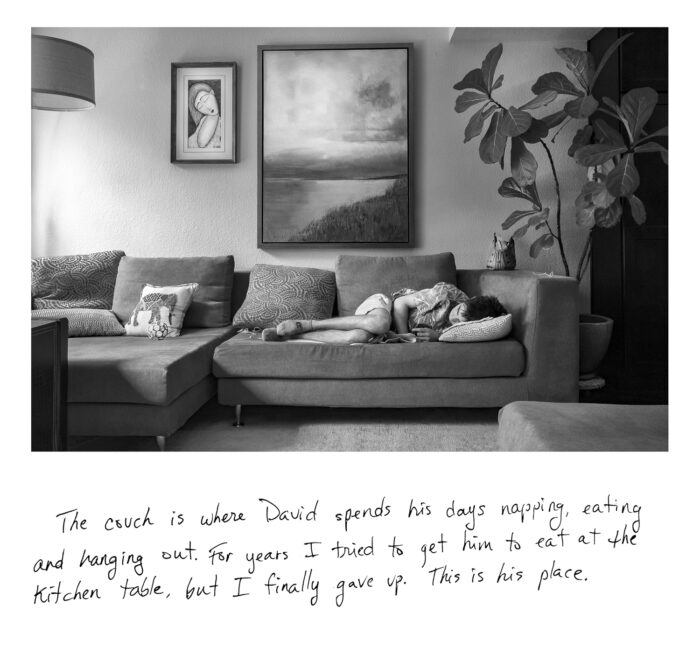
Debe, could you tell me a bit about your relationship with Lori and David?
Debe: “Lori and I have always been close. She’s my baby sister, and I’ve always looked out for her. And because she’s the amazing person she is, she looks out for me too. When David was diagnosed, we lived across the country from each other. I supported her from afar with phone calls, emails, and visits. When life was heavy, I took it upon myself to be ridiculously silly and make her laugh.
“Lori inspires me in many ways. She’s a pillar of strength. She’s courageous, resilient, smart, and perfectly goofy. She’s David’s advocate and an alchemist by way of caring for him. Her dedication to David and her own self-care (physical, mental, emotional, and spiritual) is what makes her beyond remarkable. With all the sacrifices she endures, she always has reserves to be there for other family members and friends.
“Early on, David was neutral to people entering or leaving a room and he didn’t like to be touched. Now, so many years later, he shows affection by leaning in and resting his head on my shoulder. It’s super sweet. He seems to have a good sense of humor. When I tease Lori, David gets this great smirk on his face letting us know he’s in on the joke. It’s hilarious.”
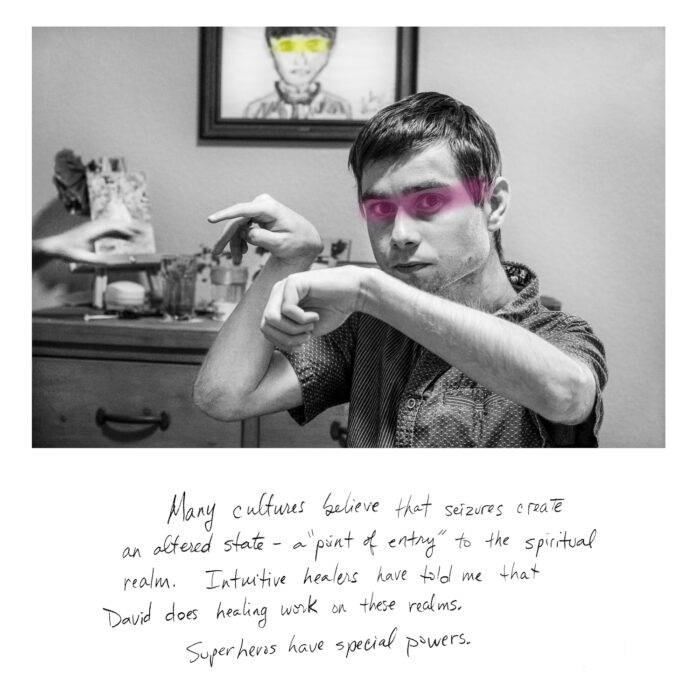
How and when did you start collaborating with your sister and nephew in this way?
Debe: “During the first summer of the pandemic, I was aching to be with my family in Colorado so I drove out from California, intending to stay for maybe ten days. During the first few days, I was photographing Lori and David at home, as I’ve done over the years on occasion. Nothing major, just family photos.
“Only this time, in my mind I heard a clear message: ‘You need to make a project about Lori and David.’ I stopped in my tracks, knowing I was being directed by a higher realm. I had no idea what the project would look like or how to proceed. I felt my heart open and knew by taking on this project, my first documentary, I’d be acting upon a life purpose. Odd as it may sound, I knew everything I had done creatively up until that moment would lead me to make this work.”
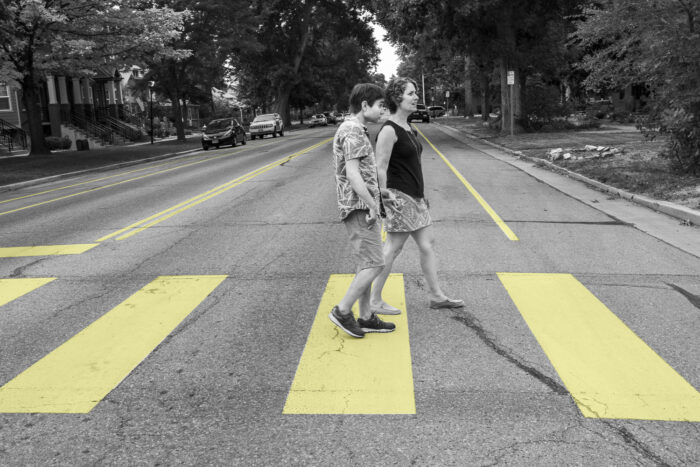
Lori, why did you trust your sister to tell your story and David’s?
Lori: “I trust my sister because she, more than anyone else on this earth, knows what I have gone through in the struggles of being David’s mom. She’s always been there for me, to listen to my pain, to witness my struggles and my victories, to hear me cry, laugh, and rage. She’s not only my blood sister; she’s my friend and my soul sister. We are journeying in step with one another. We speak the same language of personal and spiritual growth. She is my confidante. Who better to tell my story?”
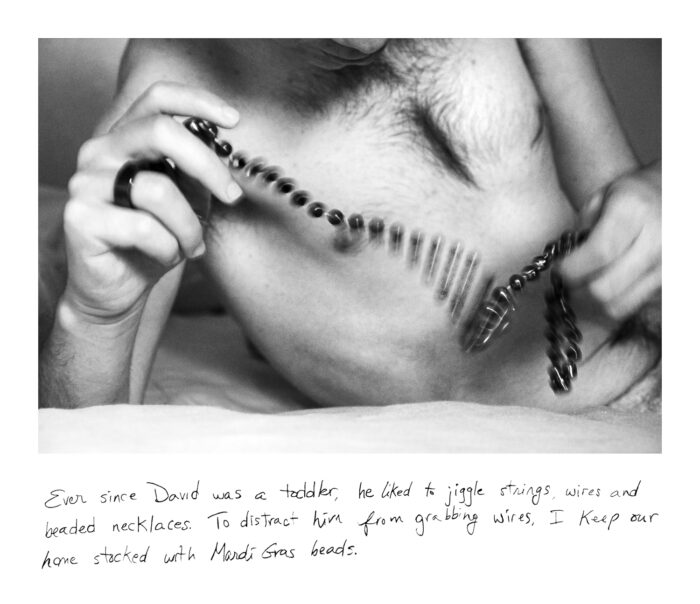
Can you tell me a bit about LGS and how it’s shaped your family’s life? Your life?
Lori: “LGS is a brain disorder that develops in early childhood. Its features are abnormal brain activity, multiple seizure types that are resistant to treatment, and neurological impairment. From one perspective, LGS is a monster that has ravaged my son’s brain, lurking in the shadows, always present with the threat of physical harm from a seizure.
“From another, his disability draws out great compassion, sensitivity, and love throughout our family, from my friends and even strangers. Our nephew is going to med school because of seeing the effects of David’s seizures. He’s been working in epilepsy research since he was an undergrad pre-med student.
“As for me, well, my whole life since he was born has been devoted to his care. And in order to do that well, I’ve learned how to prioritize my own self-care. I exercise outdoors and meditate regularly. That’s how I resource myself to get up at all hours during the night when David has a seizure, needs the toilet (or has an accident in bed), or is just awake and making loud happy sounds at 4:00 AM! It was much, much harder when David was young and I had two other kids to raise as a single parent.
“Aside from the physical demands, the emotional and psychological tolls of having a child with severe disabilities are enormous. My spiritual and personal growth practices have been the scaffolding that have not only helped me climb out of depressive states but have enabled me to keep my perspective wide–wide enough to feel the deep pain and grief of seeing my son injured from a seizure and to know that this terrible moment will pass, he’ll be okay, and we’ll return to the calm and love that underlies everything.”
Can you tell us more about your work with nonconventional healers?
Lori: “David has been treated by a Tibetan Buddhist monk in New Jersey, John Upledger (the ‘father’ of craniosacral therapy) in Florida, John of God (the famed spiritual healer in Brazil), an herbal healer in Ukraine, and multiple energy workers in Colorado. They’ve all contributed something to our healing journey–unfortunately, not always positively. Today, we stick with a local craniosacral therapist who comes to our home regularly. He enjoys her touch and her presence.
“I always had an interest in the spiritual realm but really pursued teachings and practice after the break-up of my marriage. It was such an intense period of my life. I knew that the events I was experiencing—the break-up and David’s condition—had some greater meaning that I didn’t understand. I knew that there was a broader context to it all, and I wanted to understand what that was. So I dove into spiritually-based personal growth books, attended talks and retreats with spiritual teachers, and learned to meditate. It’s been quite a journey.”
Have these nonconventional healers been helpful?
Lori: “None have helped with the seizures. The only real benefit I’ve seen is the lessening of David’s sensory defensiveness. He used to hate to be touched. Now he enjoys head massages, overall body pressure, and (sometimes) foot massages. I’ve learned that not everyone who calls themselves a healer has good intentions, but many do.”
What does a typical day in your and David’s life look like? Do you have a routine?
Lori: “David doesn’t have a set routine. The days mostly work around his energy level, which is affected by seizures and medication side effects. We’re almost always working with a new seizure medication because none of them have helped to control seizures enough to consider it ‘successful,’ or if they do, David experiences side effects too disruptive to his quality of life to stay on the med. So it’s hard to make plans or have a schedule.
“My family and friends know that if we do arrange to meet, it’s always ‘David dependent.’ He’s taught me to hold all plans loosely and be super flexible. Sometimes that’s hard when I really want to get out of the house. I love my home but can get cabin fever. Fortunately, we have two wonderful caregivers who come four days a week so I can live my life apart from David’s care.
“What I can count on is David preferring to linger in bed in the morning. That gives me time for my meditation, breathing exercises, and yoga. The rest of the morning is taken up with David’s brief stretching and massage, shower, dressing, cooking, and eating. I love to cook for him, and I make super healthy breakfasts. It can take a long time to get a meal into him because seizure meds curb his appetite. He often doesn’t feel hungry even if he hasn’t eaten for many hours.
“After breakfast, he might fall back to sleep. When he’s ready, I’ll pack lunch and we’ll go for a walk, either in our neighborhood or a nearby hiking trail. This is where David gets his physical therapy—on the trails. He has to look where he’s walking, something he doesn’t naturally do, and navigate over roots and rocks. I love hiking and love taking him to easy trails when he’s up for it.
“If it’s a day when David doesn’t have the energy to get outside, I’ll get things done while he rests or sit with him and read aloud. If he’s up for it, we’ll do some interactive play with balls. He often enjoys just sitting, looking out the window, and listening to music.
“In the evening, I’ll prepare a delicious dinner. It’s a time I look forward to. I always have music playing or a podcast, sometimes pour a glass of wine, and let my creative culinary juices flow. I typically spend the rest of the evening getting David to eat what I made. He typically doesn’t finish dinner till 9:00 PM, sometimes eating very little. Then it’s off to bed. That’s a typical day.”
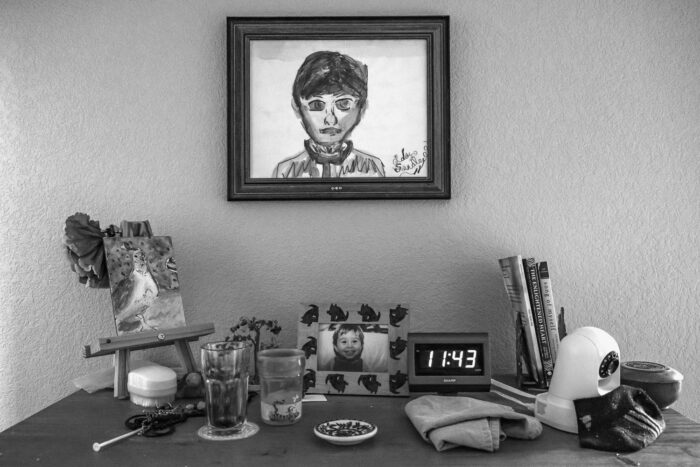
In what ways is David able to communicate? What are some of his interests or favorite things?
Lori: “David communicates through vocalizations—happy and frustrated sounds, mostly—and body language, smiles, eye contact (frequent with me, not so much with others), reaching, pushing away, turning away. He’ll get up and walk to the front door when he wants to go for a walk. He’ll stand at the bathroom door, waiting for assistance, when he needs the toilet.
“He loves various kinds of music that have soul, from classical to funk to a cappella. When he’s not too sound sensitive, he likes it loud and smiles when I dance in front of him. He really enjoys going on our neighborhood walks, sitting on benches, doing gentle hikes in the foothills of the Rocky Mountains, and playing with his beads—that’s a big pastime.”
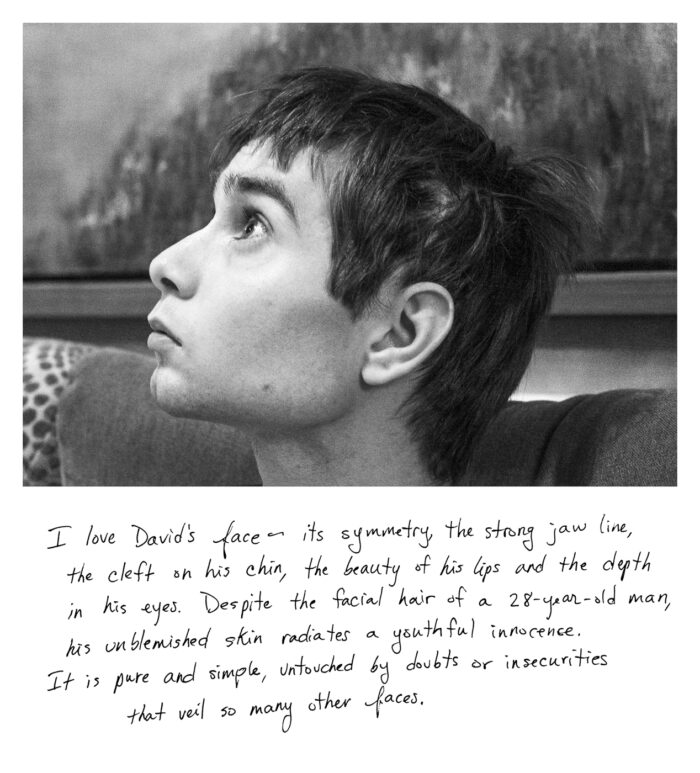
How are you and David doing now?
Lori: “David continues to have near-daily seizures and we continue to try different seizure medications. He’s doing the best he has been in terms of the number of seizures, but he’s having more drop seizures that are dangerous if he’s standing when they occur. He’s eating well and getting out for daily walks, so that’s really great.
“Since the installation of one, one thousand… at the University of Colorado, I have been invited to speak to university students, neuroscience clinicians, and researchers. Debe and I will speak at the gallery on November 1st, International Lennox-Gastaut Awareness Day. These talks have given my life greater purpose.
“For the past 28 years, my life has been centered around David’s care. Though I’ve been working part-time as a life coach and lead a support group for parents of adult children with disabilities, I’ve wanted to make a larger impact in the world. I’ve grown so much in these years of caring for David.
“He, along with many other great teachers, has taught me what’s most important in life and how to live it well, with all the pain and sorrow that accompanies the human condition. Now I’m getting a chance to share what I’ve learned.”
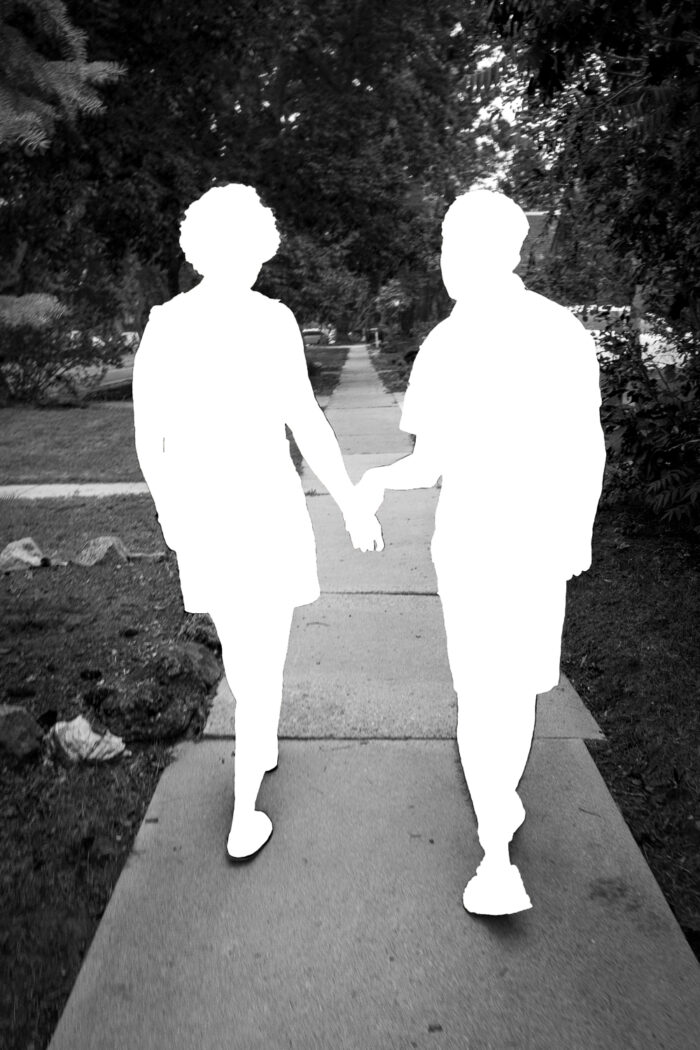
Debe, in what ways, if any, has your approach to making this work changed over the last two years?
Debe: “one, one thousand… is continually evolving. When I first began shooting, I knew I didn’t want it to be a straight documentary, but I had no idea what that would look like. I began shooting reportage knowing the project would reveal itself over time.
“Eight months after I began the project, I took a workshop with Guggenheim Fellow, Daniel Coburn. He encouraged us to break photography tradition and give ourselves license to create freely. This allowed me to play without fear of what others might say about the work. Daniel’s encouragement was an eye-opener, and I played.
“I mixed multiple artistic interpretations that previously I would have thought of as taboo. I used different styles and techniques I’ve used throughout my practice and new ones. All to relay unknown elements of the spiritual realm, alluding to Lori’s practice and the unanswerable questions I have about David.
“Is he a healer working in other planes to help people? Is he intelligent? Does he have synesthesia, as an estimated 70% of people with autism do? Is his vision distorted? What does he think and feel? I wanted to portray what is ‘real’ and what is outside our scope of understanding.
“Six months later, I was prepping for a solo exhibition for a Lennox-Gastaut Syndrome Fundraiser. I realized the photographs alone were not enough to educate viewers about LGS and the experiences Lori and David have. We needed captions. This shifted the project even more and elevated its cadence. It evolved into my desire to have Lori’s fingerprint, as it were, on the images. I asked her to handwrite descriptive narratives for selected photographs, which became part of the images.
“I was careful to make work showing the care and love Lori has for David…and the love I have for them both. I felt I had honored them with each image. As we were installing our exhibit at the University of Colorado Anschutz Medical Campus, Fulginiti Pavilion for Bioethics and Humanities this September, Lori told me she had great discomfort with some of the photographs. I was shocked and confused.
“We spoke about it at length, and I saw it was challenging for her. I gave her the time she needed to look into what she was experiencing. After all, it wasn’t me exposing my private, personal life.
“Lori’s dedication to personal growth and going deep into the why of her discomfort enabled her to see the work with refreshed eyes. This is one example of my sister’s courage that is a throughline in her life. We’ve come to understand this story is not just about them. It’s about all long-term family caregivers; it’s about bringing awareness to this rare, incurable epilepsy disorder; it’s about autism; it’s about family.”
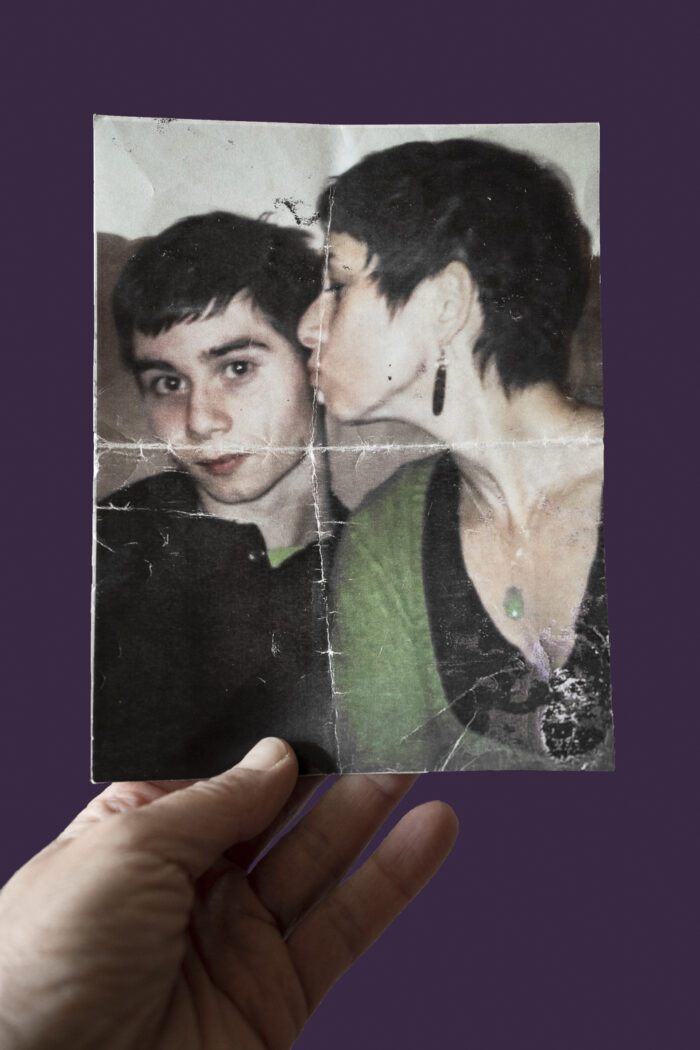
All images © Debe Arlook. Debe Arlook is a Top 50 finalist for Photolucida’s Critical Mass.



Leave a Reply